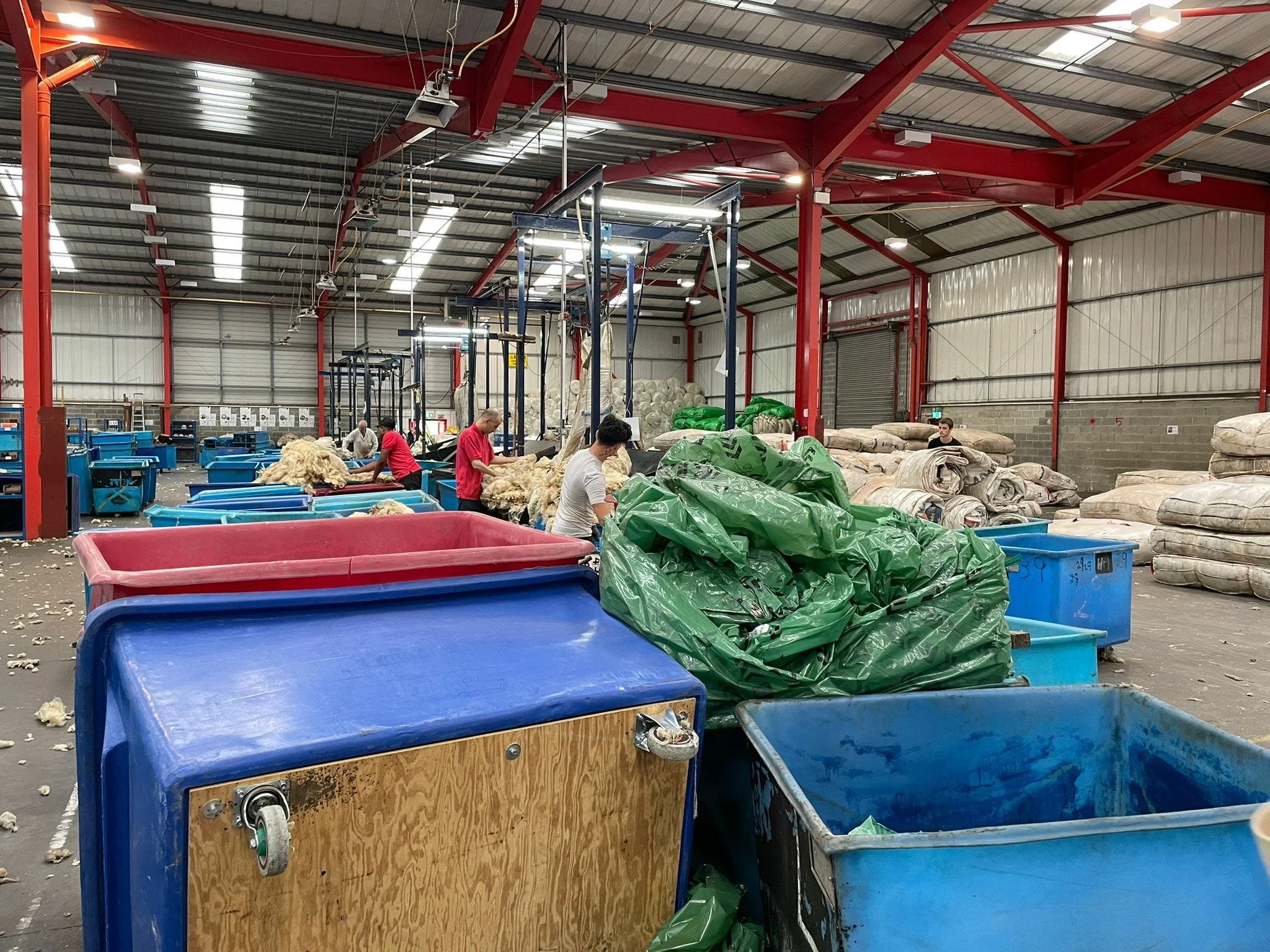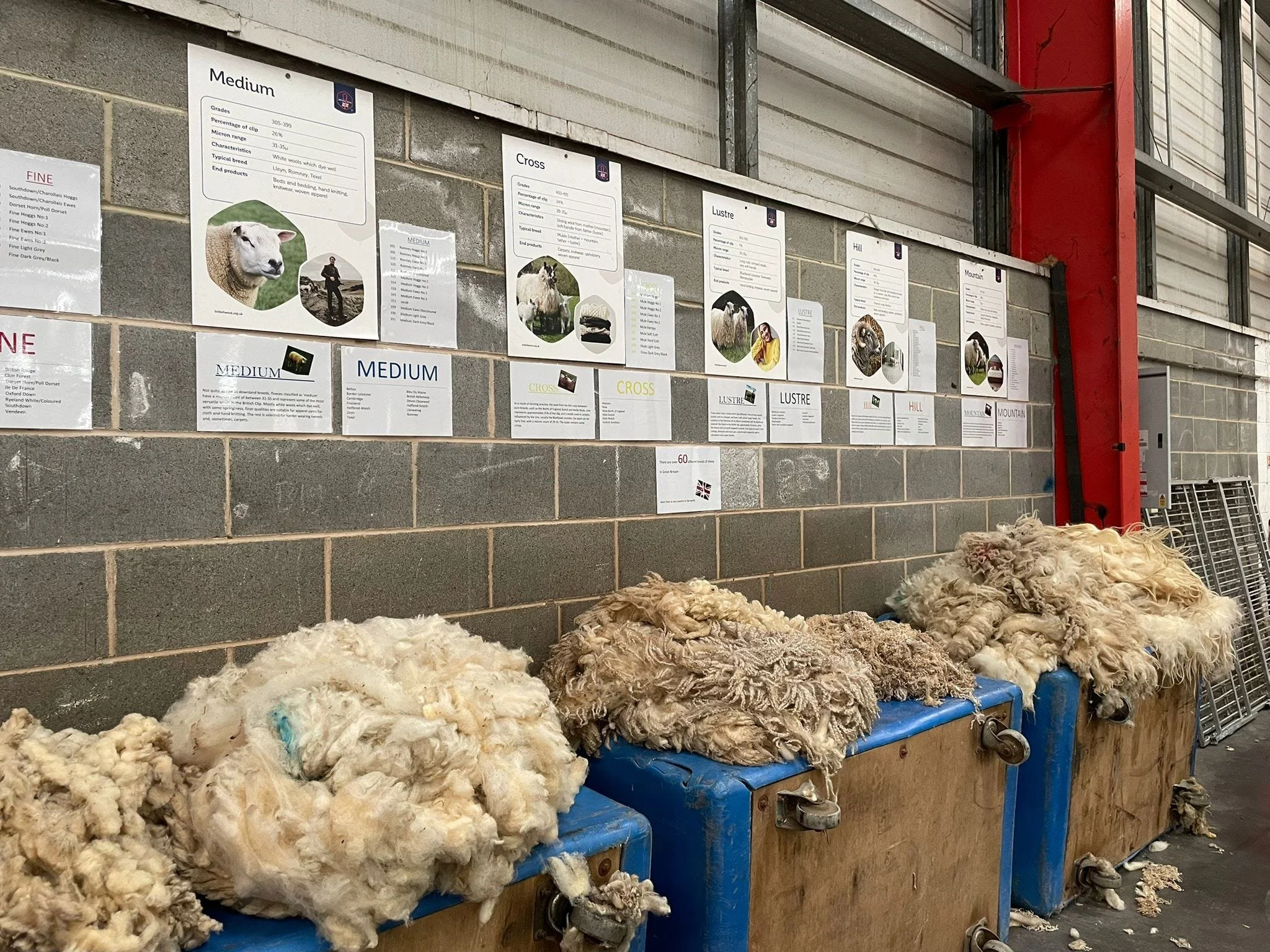Last week, Harriet, our Textiles Researcher, visited the impressive British Wool depot in Bradford to learn about its intricate grading process, and ongoing efforts to drive demand for British wool!
By Harriet Fletcher-Gilhuys
After a bustling train journey up through the lavishing rolling hills of Yorkshire, I arrived at the British Wool head office, the ‘Wool House’ which is housed within the wider industrial warehouse of the extensive British Wool depot.
British Wool depot, warehouse. Image Credit: Harriet Fletcher-Gilhuys
The day began with an educational overview and introduction by Graham Clark (Director of Marketing) and Haldi Kranich-Wood (Business Development), which covered the history of British Wool (former British Wool Marketing Board), its long-standing commitment to supporting British farmers by driving demand for British wool at scale, and its proud agricultural heritage.
In the head office, there is a wide range of garments and products all made from the flocks and farmers that British Wool supports, all clearly labelled with the familiar shepherds crook mark. From garments to blankets and mattresses, each distinctive product highlights the versatility of British sheep breeds and the wide range of fleeces that can be produced.
I was then taken on a tour around the depot, to see and understand the process, from bagging and collection at farm level to sorting and grading at a large industrial scale. We entered the depot, where I was surrounded by an array of green bags, all highly organised into a numbering system to ensure wool transparency and consistency from farmer to end product.
Once the sheep have been shorn, farmers are encouraged to roll and bag up their fleeces (using the wool sheets provided and reused by British Wool) in the most convenient and efficient way for them. This differs slightly from other farms that I have worked at, where wool handlers are encouraged to remove dag wool, vegetation and handle the fleeces into a sorting process.
With neither option right or wrong, British Wool allows ease for all farmers to ensure that the process is as straightforward and convenient for them, reducing the time each farmer needs to spend during the shearing and bagging process.
Once the wool sheets (bags) arrive at the depot, the fleeces go through an intensive grading process which is all done by hand, down to exact precision to ensure consistency. I was fortunate enough to witness this first hand, where each skilled grader picked up a fleece and spent no longer than 10 seconds analysing the fibre, crimp and quality before putting it into the appropriate blue container.
This also included a small team of apprentice graders, who undergo intensive years of training on over 100 different grades, to progress to fully qualified graders. This is great as it supports UK manufacturing and hand skills, by encouraging younger generations to take up grading, which is a highly skilled and rewarding career choice. A lot of these hand skills and artisan crafts are often forgotten about in the modern day as we become more reliant on technology and AI.
However, with the development of technology, jobs that include hand-skills and artisan craftsmanship are becoming more vital to ensure the future proofing of jobs for the next generation.
Image shows the the graders and apprentice graders sorting fleeces. Image credit: Harriet Fletcher-Gilhuys
We continued on the tour, which consisted of a visual breakdown of each grade, what typical breeds fit each criteria, typical characteristics and suitable end product. The grades consist of fine, medium, cross, lustre, hill and mountain - each fleece is graded on visual quality, rather than its specific breed or staple length. This ensures that each fleece is treated equally and pushed to its best potential and performance outcome.
Visual breakdown of each grade. Image credit: Harriet Fletcher-Gilhuys
Fine/Speciality breakdown. Image credit: Harriet Fletcher-Gilhuys
We finished the tour with an overview of British Wool’s traceability scheme, which ensures full traceability from farm to end product and allows a higher return on wool price back to each farmer. This allows for brands to use a unique QR code which links back to each specific farm and flock ensuring greater transparency.
This is very similar to our goals and ambitions at The Great British Wool Revival, which champions British wool and transparency by ensuring that garments and products can be traced back to each farmer in the supply chain, joining the dots from farmer to designer. Our long-term goals aim to champion fibre sovereignty, aligning both food and fibre in harmony with people and planet, and ensuring that British wool is fully supported across the entire value chain.
It is great to see the incredible work that British Wool have been doing for so many years, and its core position as a farmer-led cooperative. We hope that with the development and on-going roll out of its traceability scheme, this will help to ensure a higher price for farmers and encourage a stronger and consistent wool trade across multiple sectors.
As initiatives within this space continue to grow, we can help to champion and future proof this incredible fibre and ensure it once again reaches its full potential!




